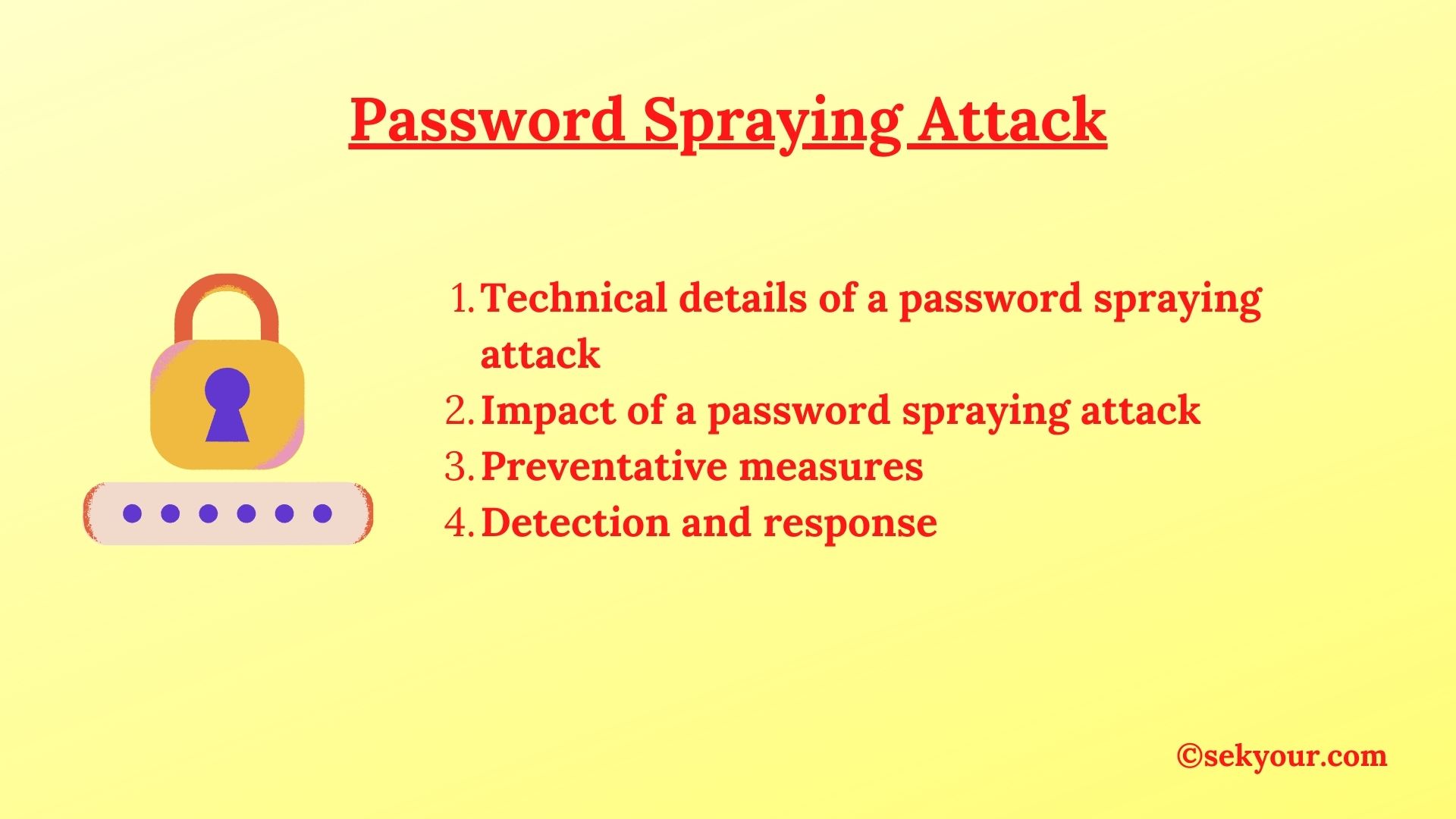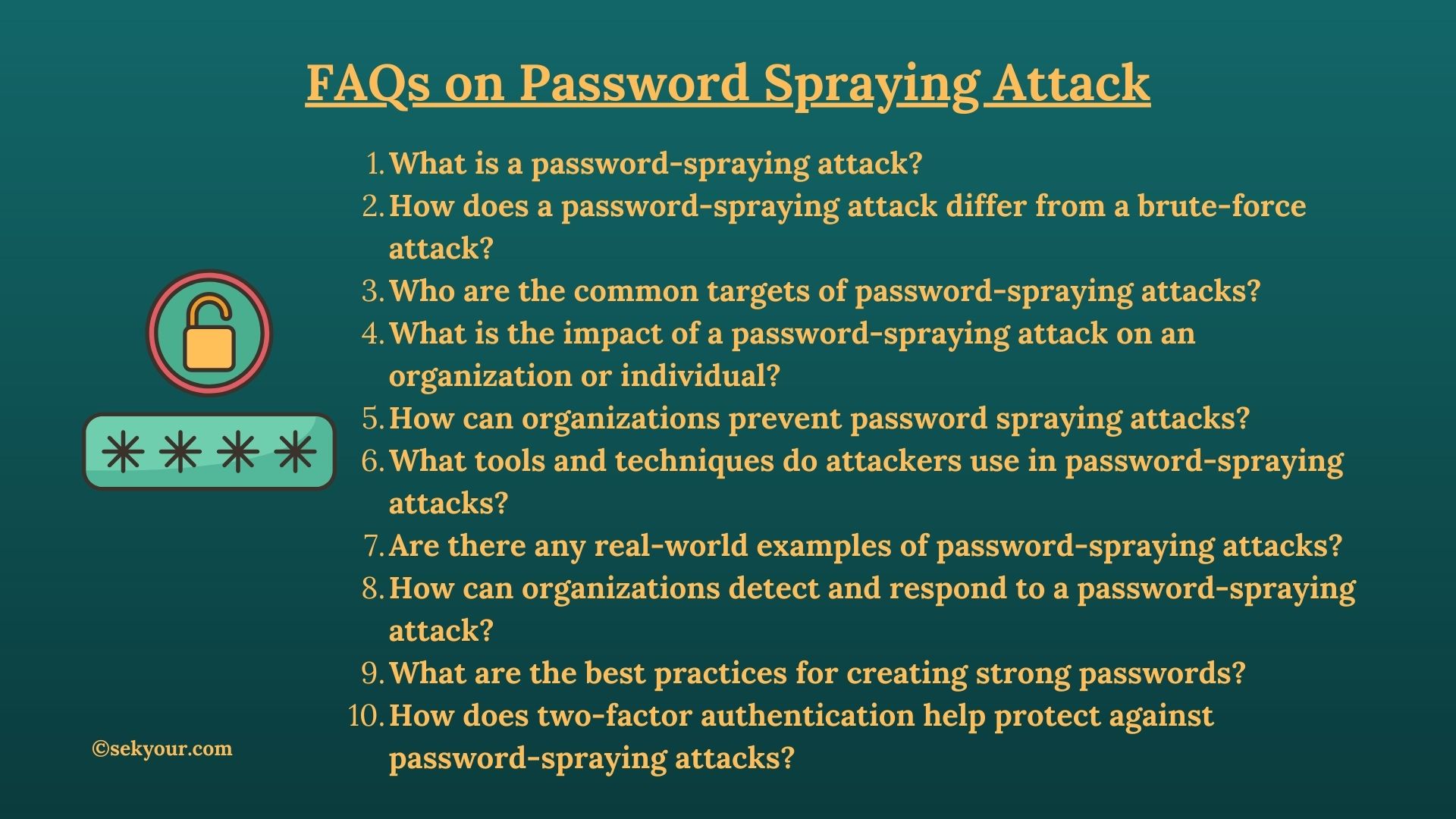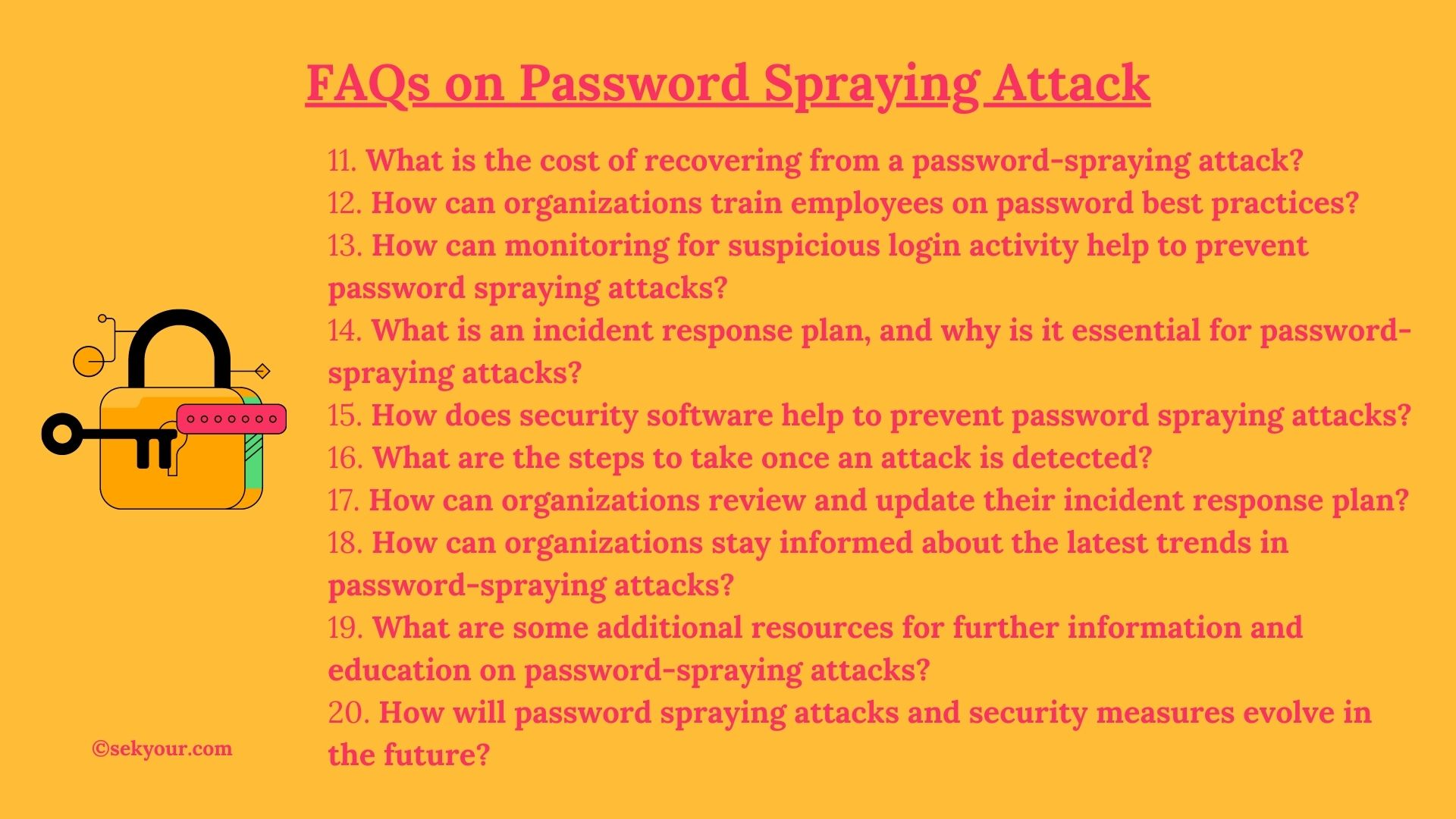1. Introduction
A password spraying attack is a type of cyber attack in which an attacker attempts to gain unauthorized access to many accounts by repeatedly trying a small list of commonly used passwords. This differs from a brute force attack, which involves repeatedly trying a large number of passwords in an attempt to guess a specific account’s password.
Targets of password spraying attacks are often large organizations, such as corporations and government agencies, as well as smaller businesses and individuals. These attacks can result in significant financial loss and damage an organization’s reputation.
It is essential to implement password spraying attack prevention measures, such as strong password policies and multi-factor authentication, to protect against these types of attacks. Additionally, monitoring for suspicious login activity and regularly reviewing access permissions can help to detect and prevent password spraying attacks.

2. Technical details of a password spraying attack
A password spraying attack is a type of cyber attack in which an attacker attempts to gain unauthorized access to many accounts by repeatedly trying a small list of commonly used passwords. The attacker uses automated tools to constantly attempt to log in to a targeted system using a list of common or previously breached username and password combinations.
The tools used in password spraying attacks are often publicly available, such as automated scripts and software programs that automate the login process. Attackers may also use botnets, allowing them to perform the attack from many different IP addresses to evade detection.
Examples of real-world password spraying attacks include the 2017 attack on the City of Atlanta, in which attackers used a password spraying technique to gain access to the city’s computer systems, and the 2018 attack on the hotel chain Marriott, in which attackers used a similar approach to gain access to the personal information of 500 million customers.
To protect against password spraying attacks, it is essential to implement strong password policies, such as requiring unique, complex passwords and regularly updating them. Multi-factor authentication can also prevent these types of attacks by adding layer of security. Additionally, organizations can monitor for suspicious login activity and regularly review access permissions to detect and prevent password-spraying attacks.
3. Impact of a password spraying attack
A password-spraying attack can significantly impact the targeted organization or individual. The damage can include unauthorized access to sensitive information, disruption of operations, and financial loss.
If an attacker successfully gains access to a system, they may steal sensitive information such as personal data, financial information, and trade secrets. This can lead to data breaches and loss of trust from customers and partners.
The costs associated with recovering from a password spraying attack can include the cost of forensic investigations, legal fees, and loss of business. In addition, costs may be associated with notifying affected individuals and providing credit monitoring services.
Preventing password spraying attacks in the workplace includes implementing strong password policies, such as requiring unique, complex passwords, regularly updating them and training employees on password best practices. Multi-factor authentication can also help to prevent these types of attacks by adding a layer of security. Periodically monitoring for suspicious login activity and reviewing access permissions can help detect and avoid password-spraying attacks. Additionally, implementing an incident response plan can help organizations to quickly and effectively respond to a potential attack.
4. Preventative measures
Preventative measures can help to protect against password spraying attacks. Some best practices for creating strong passwords include using a combination of uppercase and lowercase letters, numbers and special characters, avoiding using easily guessed information such as personal details, and regularly updating passwords.
Two-factor authentication can also be an effective preventative measure against password spraying attacks. This method adds layer of security by requiring users to provide a second form of identification, such as a fingerprint or one-time code, in addition to their password. This makes it much more difficult for an attacker to gain unauthorized access to an account, even if they have obtained the correct password.
Monitoring for suspicious login attempts can also be an effective way to detect and prevent password spraying attacks. This can include monitoring for a large number of failed login attempts from a single IP address, or for a large number of failed login attempts using a single username and password combination.
Finally, implementing security software, such as firewalls, intrusion detection and prevention systems, and security information and event management (SIEM) can help organizations to detect and prevent password spraying attacks. These systems can monitor network traffic, detect and block suspicious activity, and alert security teams to potential threats.
5. Detection and response
Detection and response are critical components of protecting against password spraying attacks. Identifying a password spraying attack can include monitoring for a large number of failed login attempts from a single IP address, or for a large number of failed login attempts using a single username and password combination. Monitoring for unusual network traffic or system behavior can also indicate a potential attack.
Once an attack is detected, it is essential to take immediate action to contain and mitigate the damage. This may include isolating affected systems, shutting down or blocking access to affected accounts, and notifying relevant parties.
Best practices for incident response and recovery include having a well-defined incident response plan, regularly testing and updating the plan, and providing training for employees on how to respond to a password-spraying attack. The incident response plan should include steps for identifying and containing an attack and steps for recovery and restoring normal operations.
Finally, it’s essential to regularly review and update the incident response plan and ensure it aligns with the organization’s security strategy. This helps to ensure that the organization is prepared to respond quickly and effectively in the event of a password spraying attack.
6. Conclusion
A password spraying attack is a type of cyber attack in which an attacker attempts to gain unauthorized access to many accounts by repeatedly trying a small list of commonly used passwords. This type of attack can have significant impact on the targeted organization or individual, including unauthorized access to sensitive information, disruption of operations, and financial loss.
Preventative measures include implementing strong password policies, using two-factor authentication, monitoring for suspicious login attempts, and implementing security software. Detection and response are also critical components of protecting against password spraying attacks, including identifying an attack, taking immediate action to contain and mitigate the damage, having a well-defined incident response plan, and regularly reviewing and updating the plan.
The future outlook for password spraying attacks and security measures includes the continued evolution of the attack methods and techniques used by attackers and the development of more advanced security measures to protect against these attacks. Organizations should stay informed about the latest trends in password spraying attacks and ensure that their security measures are up-to-date.
Additional resources for further information and education include industry publications, websites, and conferences focused on cybersecurity and password spraying attacks. Additionally, organizations can seek guidance from security experts and consult with security providers for assistance with implementing effective security measures.
As password spraying attacks are becoming more frequent and sophisticated, organizations must stay vigilant and implement comprehensive security measures to protect against them. This includes technical measures, an ongoing process of awareness and education for employees, and regular testing of incident response plans. This will help organizations to stay ahead of the attackers and maintain the trust of their customers.
7. FAQs on Password Spraying Attack

1. What is a password-spraying attack?
A password spraying attack is a type of cyber attack in which an attacker attempts to gain unauthorized access to many accounts by repeatedly trying a small list of commonly used passwords.
2. How does a password-spraying attack differ from a brute-force attack?
A brute force attack involves repeatedly trying a large number of passwords in an attempt to guess a specific account’s password. In contrast, a password spraying attack involves repeatedly trying a small list of commonly used passwords to gain access to many reports.
3. Who are the common targets of password-spraying attacks?
Targets of password spraying attacks are often large organizations, such as corporations and government agencies, as well as smaller businesses and individuals.
4. What is the impact of a password-spraying attack on an organization or individual?
A password spraying attack can have significant impact on the targeted organization or individual, including unauthorized access to sensitive information, disruption of operations, and financial loss.
5. How can organizations prevent password spraying attacks?
Implementing strong password policies, using two-factor authentication, monitoring for suspicious login attempts, and implementing security software are among the preventative measures organizations can take to protect against password spraying attacks.
6. What tools and techniques do attackers use in password-spraying attacks?
Attackers use automated tools to repeatedly attempt to log in to a targeted system using a list of common or previously breached username and password combinations. Attackers may also use botnets, allowing them to perform the attack from many different IP addresses to evade detection.
7. Are there any real-world examples of password-spraying attacks?
Examples of real-world password spraying attacks include the 2017 attack on the City of Atlanta, in which attackers used a password spraying technique to gain access to the city’s computer systems, and the 2018 attack on the hotel chain Marriott, in which attackers used a similar approach to gain access to the personal information of 500 million customers.
8. How can organizations detect and respond to a password-spraying attack?
Organizations can detect password-spraying attacks by monitoring for many failed login attempts from a single IP address or for many failed login attempts using a single username and password combination. Once an attack is detected, organizations should take immediate action to contain and mitigate the damage, such as isolating affected systems, shutting down or blocking access to affected accounts, and notifying relevant parties.
9. What are the best practices for creating strong passwords?
Best practices for creating strong passwords include using a combination of uppercase and lowercase letters, numbers and special characters, avoiding using easily guessed information such as personal details, and regularly updating passwords.
10. How does two-factor authentication help protect against password-spraying attacks?
Two-factor authentication adds layer of security by requiring users to provide a second form of identification, such as a fingerprint or one-time code, in addition to their password. This makes it much more difficult for an attacker to gain unauthorized access to an account, even if they have obtained the correct password.

11. What is the cost of recovering from a password-spraying attack?
The costs associated with recovering from a password spraying attack can include the cost of forensic investigations, legal fees, and loss of business. In addition, costs may be associated with notifying affected individuals and providing credit monitoring services.
12. How can organizations train employees on password best practices?
Organizations can train employees on password best practices by providing regular training sessions, distributing educational materials, or hosting workshops. Additionally, organizations can enforce strong password policies and best practices, like using multi-factor authentication, and providing regular reminders to employees.
13. How can monitoring for suspicious login activity help to prevent password spraying attacks?
Monitoring for suspicious login activity, such as a large number of failed login attempts from a single IP address or for a large number of failed login attempts using a single username and password combination, can help organizations to detect and prevent password spraying attacks.
14. What is an incident response plan, and why is it essential for password spraying attacks?
An incident response plan is a set of procedures and guidelines that an organization follows when responding to a security incident, such as a password-spraying attack. It is essential to have a well-defined incident response plan to ensure that the organization is prepared to respond quickly and effectively during an attack.
15. How does security software help to prevent password spraying attacks?
Security software such as firewalls, intrusion detection and prevention systems, and security information and event management (SIEM) can help organizations to detect and prevent password spraying attacks by monitoring network traffic, detecting and blocking suspicious activity, and alerting security teams to potential threats.
16. What are the steps to take once an attack is detected?
Once an attack is detected, it is important to take immediate action to contain and mitigate the damage. This may include isolating affected systems, shutting down or blocking access to affected accounts, and notifying relevant parties.
17. How can organizations review and update their incident response plan?
Organizations can review and update their incident response plan by regularly testing the plan, seeking guidance from security experts, and consulting with security providers for assistance with implementing effective security measures.
18. How can organizations stay informed about the latest trends in password spraying attacks?
Organizations can remain knowledgeable about the latest trends in password-spraying attacks by regularly reading industry publications, and websites, and attending conferences focused on cybersecurity and password-spraying attacks.
19. What are some additional resources for further information and education on password spraying attacks?
Extra resources for other news and education on password-spraying attacks include industry publications, websites, and conferences focused on cybersecurity and password-spraying attacks. Additionally, organizations can seek guidance from security experts and consult with security providers for assistance with implementing effective security measures.
20. How will password spraying attacks and security measures evolve in the future?
The future outlook for password spraying attacks and security measures includes the continued evolution of the attack methods and techniques used by attackers and the development of more advanced security measures to protect against these attacks. Organizations should stay informed about the latest trends in password spraying attacks and ensure that